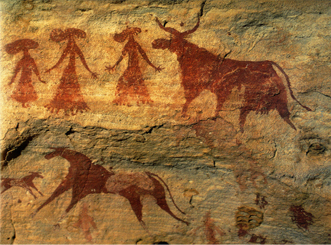History of India

Stone Age rock shelters with paintings at Bhimbetka in Madhya Pradesh are the earliest known traces of human life in India. The first known permanent settlements appeared over 9,000 years ago and developed into the Indus Valley Civilization, which peaked between 2600 BC and 1900 BC. It was followed by the Vedic Civilization.
From around 500 BC onwards, many independent kingdoms came into being. In the north, the Maurya dynasty, which included the Buddhist king Ashoka, contributed greatly to India’s cultural landscape. From 180 BC, a series of invasions from Central Asia followed, with the successive establishment in the northern Indian subcontinent of the Indo-Greek, Indo-Scythian, and Indo-Parthian kingdoms, and finally the Kushan Empire. From the 3rd century onwards the Gupta dynasty oversaw the period referred to as India’s “Golden Age”.
Pandyas prevailed during different periods. Science, Art, literature, mathematics, astronomy, engineering, religion, and philosophy flourished under the patronage of these kings.
Following the Islamic invasions at the beginning of the second millennium, much of north and central India came to be ruled by the Delhi Sultanate, and later, much of the entire subcontinent by the Mughal dynasty. Nevertheless, several indigenous kingdoms remained in or rose to power, especially in the relatively sheltered south.
During the middle of the second millennium, several European countries, including the Portuguese, French, and English, who were initially interested in trade with India, took advantage of fractured kingdoms fighting each other to colonize the country. After a failed revolution in 1857 against the British East India Company, popularly known as the First War of Indian Independence, most of India came under the direct administrative control of the crown of the British Empire.
A prolonged and largely non-violent struggle for independence, the Indian independence movement, followed, eventually led by Mahatma Gandhi, regarded officially as the father of modern India. The culmination of this path-breaking struggle was reached on 1947-08-15 when India gained full independence from British rule, later becoming a republic on 1950-01-26.
As a multi-ethnic and multi-religious country, India has had its share of sectarian violence and insurgencies in different parts of the country. Nonetheless, it has held itself together as a secular, liberal democracy barring a brief period from 1975 to 1977 during which the then Prime Minister Indira Gandhi declared a “state of emergency” with the suspension of civil rights. India has unresolved border disputes with China, which escalated into a brief war in 1962, and Pakistan which resulted in wars in 1947, 1965, and 1971, and a border altercation in the northern state of Kashmir in 1999. India was a founding member of the Non-Aligned Movement and the United Nations(as British India). In 1974, India conducted an underground nuclear test, making it an unofficial member of the “nuclear club”, which was followed up with a series of five more tests in 1998. Significant economic reforms beginning in 1991, have transformed India into one of the fastest-growing economies in the world.
Suggested Read: A Concise History Of India
